Iranian nowruz traditions | From the customs before Nowruz until the 13th
The main origin of the Nowruz celebration lies in ancient Iran. According to mythical narratives, Nowruz came into existence during the time of Jamshid, the fourth king of the Pishdadian dynasty in ancient Iran. In the Avesta, one of the oldest books of ancient Iran, there is mention of a figure named Jamshid, who possessed divine power. Following the command of Ahura Mazda, Jamshid begins to confront Ahriman, as Ahriman had caused significant damages such as famine and drought at that time. After Jamshid defeats Ahriman, joy and prosperity return to the land of Iran, and the drought disappears. Later, people named this day “Nowruz” or “New Day.” Renowned poets and writers such as Ferdowsi, Abu Rayhan Biruni, and Tabari also consider Jamshid as the primary founder of Nowruz.
Why is Nowruz celebrated for thirteen days?
In the ancient beliefs of Iranians, Nowruz lasted for 12 days, and the thirteenth day was added for warding off misfortune and bringing order to the situation. In ancient times, people, especially Iranians, believed that the creation of the Earth and its blessings would come to an end over the course of 12 thousand years. They also believed that the 12 months of the year manifest in the 12 days of Nowruz. What occurred during these twelve days was considered to influence the fate of their year. For example, there were beliefs related to planting seeds during these twelve days and observing the growth process. Farmers in the past would choose seeds that showed more growth during these 12 days for planting and considered it a good omen.
Philosophy of Sizdah Bedar
Just as ancient Iranians believed that after twelve thousand years, the world would come to an end, and turmoil, misfortune, and destruction would prevail everywhere, the twelve days of Nowruz celebration also led to a day of chaos, known as the thirteenth day of Nowruz. The superstition of the thirteenth day signifies the collapse of the world and its destruction. For this reason, Iranians believe that staying at home on this day is inauspicious and brings bad luck. Iranians believe that they should spend this day outdoors, in nature.
Which Countries Celebrate Nowruz?
As mentioned, Nowruz is one of the oldest surviving celebrations from ancient times. Due to the vastness of ancient Iran, today, in addition to Iran, neighboring countries also celebrate Nowruz. Nowadays, Nowruz is still considered the beginning of the new year in Iran and Afghanistan, and more than other countries, authentic Nowruz customs and traditions are observed and practiced. In some other countries such as Tajikistan, Russia, Kyrgyzstan, Kazakhstan, Syria, Iraq, Georgia, Azerbaijan Republic, Albania, China, Turkey, Turkmenistan, India, Pakistan, and Uzbekistan, Nowruz is an official holiday, and people celebrate it. In the following, you will become familiar with the customs and traditions of Nowruz in detail.
Customs and Traditions of Nowruz in Iran
The customs and traditions of Nowruz vary across different regions of Iran due to the presence of diverse ethnic groups with distinct cultures. Some of these customs are related to the period before the start of the new year, while others take place with the arrival of the new year. Below, you will become familiar with the main customs and traditions of Nowruz that are observed throughout Iran.
Chaharshanbe Suri Ceremony as a Pre-New Year Tradition
Chaharshanbe Suri is one of the sweet traditions of us Iranians, celebrated every year on the last Wednesday of the year. On this day, families gather together, celebrate Chaharshanbe Suri by eating sweets and nuts. Additionally, by lighting a fire and jumping over it, they express their hopes for the fulfillment of all their wishes in the new year and warding off evil and misfortune. Other customs of Chaharshanbe Suri include taking omens from Hafez’s poetry and playing the “Bouloni” game. The spoon banging and breaking a pot are also part of the Chaharshanbe Suri customs.
Pot Breaking Ceremony:
In this ceremony, after lighting some charcoal symbolizing bad luck, throwing some salt symbolizing bitterness of life, and a coin symbolizing tightness of fortune into a pot, all family members would take turns spinning the pot around their heads. The last person would climb to the roof and say, “I’ve thrown the pain and affliction of this house into the alley,” then toss the pot into the alley. This ritual was believed to ward off pain, affliction, and misfortune from their homes.
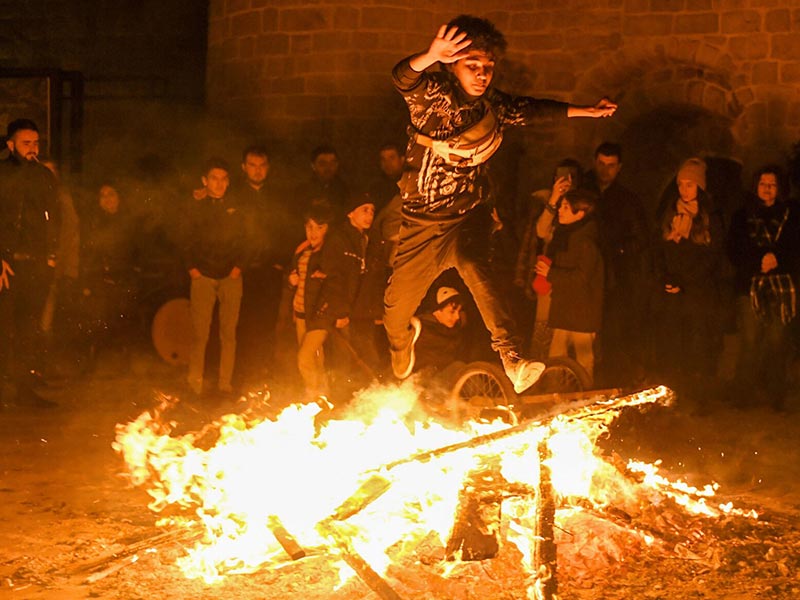
Spoon Beating (Qasheq Zani):
On the night of Wednesday, women and girls with wishes and desires would carry a copper bowl and stand in front of seven houses. They would strike the spoon onto the bowl repeatedly without uttering a word. The homeowners would fill their bowls with nuts, sweets, rice, or money.
Fortune Telling by Ear Sitting:
Women and girls with wishes, desires, or intentions to marry would make a vow on the eve of Wednesday. At sunset, they would sit by the crossroads or four-way intersections, eavesdropping on passersby. Based on the bitterness or sweetness of their conversations, they would divine their fortunes.
Wednesday’s Snack (Ajil Chaharshanbe Souri):
Women who had vows or needs to be fulfilled would buy a seven-nut mixture called “Ajil Chaharshanbe Souri” from a shop facing the Qibla (direction of Mecca). When cleaning the mixture, they would recite a specific tale related to Ajil Chaharshanbe Souri, called “The Thorn-Breaking Tale,” then distribute it among friends and relatives.
Wednesday’s Ash (Ash Chaharshanbe Souri):
Families with needs or illnesses would cook a special ash called “Ash Abodarda” on the eve of Chaharshanbe Souri. After giving a small portion to the patient, they would distribute the rest among the poor. These simple yet delightful traditions during this night symbolized the pursuit of a brighter future, indicating that better days were on the way. The symbolic rituals, starting from Chaharshanbe Souri and continuing until the end of Sizdah Be Dar, aimed to dispel negativity and invite positivity into their lives.
House Cleaning as a Cherished Nowruz Tradition
One of the cherished traditions of Nowruz is cleaning and refreshing the house. One or two weeks before the start of the new year, thorough house cleaning takes place. Carpets are usually washed, and some discard old items, replacing them with new ones. You might also consider redecorating for the new year, making the end-of-year house cleaning the perfect time for this task. By cleaning and refreshing the house, you prepare your home to welcome guests and the new year.
House Cleaning from Past to Present
It’s interesting to note that house cleaning, from an ancient perspective, initially involves excitement and upheaval. After organizing the home, calmness and order prevail everywhere. According to this tradition, ancient Iranians, with the arrival of spring, thoroughly cleaned their entire homes. Sometimes they even painted their houses, or at least the room where they set up the Haft-Seen, in white. People of that era would discard old belongings and replace them with new ones. Breaking the pot, symbolizing the impurities and sorrows of the past year, was considered obligatory. They entrusted copper utensils to polishers, polished silverware, cleared the corners and sides of the house from dust, and removed any dirt from carpets and rugs. This ritual is still common among Iranians and is performed annually by the people.
Planting Greens in the Beautiful Tradition of Nowruz
About two weeks before Nowruz, people plant various seeds such as wheat, lentils, chickpeas, and corn in decorative containers or on beautiful pots. This is done to have fresh greenery, such as wheatgrass, on the Haft-Seen table at the moment of the New Year’s transition. In the Avesta, planting greens is mentioned as a symbol of truth and virtue. Additionally, in ancient Iran, Ahriman had sent drought to the Earth. After Jamshid’s victory over Ahriman, people, as a sign of gratitude for the blessings of spring, planted various seeds in different containers. This part of the Nowruz customs may trace back to that event. During ancient times, families, especially Zoroastrians, planted wheat, barley, and lentils in three separate containers as a symbol of good thoughts, good words, and good deeds, expecting Ahura Mazda to grant them growth and prosperity.
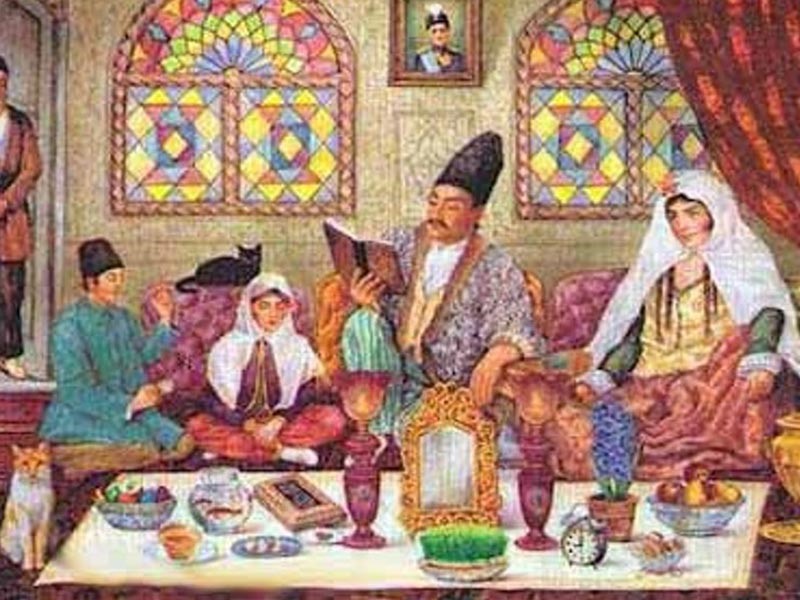
Haji Firuz: One of the Most Famous Symbols of Nowruz
Haji Firuz is one of the symbols of Nowruz who, in the final days of Esfand (the last month of the Iranian calendar), emerges onto the streets with a tambourine, dressed in red and pink, and a black-painted face. Haji Firuz joyfully announces the arrival of Nowruz to the people. He engages in Nowruz songs and recites related verses, receiving cheers from the audience.
Some famous verses of Haji Firuz include:
“The winds of spring have come, Nowruz, the king, has arrived, Rejoice, O friends, the new year has come again.”
“Haji Firuz, just one day a year, everyone knows, I know too, it’s Nowruz.”
“Break, break, break, I won’t break, break, I won’t break, I’ll break here, where my beloved is upset, I’ll break there, where my beloved is upset, this poor black one has so much patience.”
“Greetings, sir, greetings, sir, lift your head, my lord, look at me, my lord, be kind to us, my lord, sir, sir, why don’t you smile, sir?”
Visiting the Deceased and Those Resting in Tombs
Nowadays, on the last Friday of the year, Iranians visit the graves of their departed loved ones with bouquets of flowers, sweets, charitable donations, and a small arrangement of greens or a type of miniature Haft-Seen. They seek forgiveness and mercy from the Almighty for the departed souls in the new year. This tradition is typically performed to bring peace and closeness to their departed loved ones.
The Ceremony of the Return of the Deceased in Ancient Iran
Ancient Iranians believed that with the arrival of Nowruz, the spirits of the departed, known as Farohars, returned to the world. If they saw a clean home and happy relatives, they would become pleased and pray for their surviving loved ones. For this reason, a few days before Nowruz, they would burn musk and amber in their homes, light candles, and lamps. Women would cook the best meals and sprinkle them on the graves of their deceased. A day before Nowruz, known as Arafah or Horfeh, they would visit the house where someone had passed away during the year. They would pray in the house and mention that they had celebrated Nowruz for the deceased.
Haft-Seen: One of the Most Important Customs of Nowruz
Setting up the Haft-Seen table is the most prominent part of the customs and traditions of the Iranian New Year, Nowruz. As the name suggests, to set this table, you need to place seven items that begin with the letter “S” on the table.
The main components of the Haft-Seen table include Senjed (symbolizing the act of spreading kindness), Seeb (symbolizing health and love), Sabzeh (symbolizing freshness and vitality), Somāq (symbolizing resistance and justice), Sir (symbolizing humility), Serkeh (symbolizing satisfaction and surrender), and Samanu (symbolizing patience and endurance). In addition to the main “S” items, there are other elements such as Sekkeh (symbolizing increased wealth), sacred books of various religions (Quran for Muslims, Avesta for Zoroastrians, etc., symbolizing reliance on the Almighty), Āyeneh (symbolizing illumination), Māhi (symbolizing birth and effort), Shemʿ (symbolizing brightness and light), and Nān (symbolizing blessing).
sofreh haft sin | The History of Haft Sin and Secrets You Didn’t Know

Usually, the Haft-Seen table is set one day before the beginning of the new year and remains in place until Sizdah Bedar, the thirteenth day of Nowruz. The best location for the Haft-Seen table is the reception room or a place in the home where guests can easily see it. Therefore, it is recommended to use suitable decorative dishes for Haft-Seen, such as a set of Haft-Seen rice dishes.
Sabsi Polo Ba Mahi: A Popular Dish for Nowruz
Cooking Sabsi Polo Ba Mahi, a herbed rice dish with fish, is one of the most essential customs and traditions of Nowruz. Typically eaten for lunch or dinner on the first day of Farvardin, the philosophy behind cooking this dish is likely related to the symbolism of each ingredient.
The fish symbolizes life and vitality, the herbs represent spring and growth, and rice is a symbol of abundance. In addition to these, cooking and eating Sabsi Polo Ba Mahi is an opportunity for expressing gratitude on the first day of the new year. Some Iranians, like the people of Zanjan, eat the fish with Reshte Polo or Saffron Polo, while others serve it alongside Kuku or local stews. Some Tehranis also cook Reshte Polo on the eve of Nowruz to have a ready-made dish on hand throughout the year.
Visiting and Sightseeing in the Pleasant Customs of Nowruz
Almost after the turn of the year, visiting and sightseeing begins. Usually, in the first days of Nowruz, smaller family members visit their elders to congratulate them on the New Year. These greetings continue during the first days of Farvardin. Additionally, people visit those who lost their loved ones in the past year to express condolences and share in their grief. These visits provide an excellent opportunity to mend familial relationships. Reconnecting with relatives is one of the most recommended actions during this time, serving multiple purposes.
Sizdah Bedar: One of the Most Exciting Nowruz Rituals
As Iranians believe that going into nature on the thirteenth day of the year can ward off misfortune, Sizdah Bedar is considered one of the most exciting Nowruz rituals. On this day, young people tie the grass from the Haft-Seen table into knots and throw it into running water. Iranians believe that tying knots in the grass helps fulfill wishes and opens the luck for the youth. Usually, mothers cook Ashe (a type of soup) for lunch on this day. In some regions like Kurdistan, they make Dolemeh Barg-e-Mow (stuffed grape leaves) instead of Ashe for Sizdah Bedar. Cucumber and lettuce are among the popular foods consumed on this day. Eating leftover nuts from the twelve days of Nowruz is also common. Engaging in various group games with relatives and friends is one of the favorite activities during Sizdah Bedar, making it one of the most exhilarating Nowruz rituals.
Now that you are familiar with the customs and traditions of Nowruz, what do you think is the most fascinating Nowruz ritual? What is the best Nowruz celebration you have ever had? If there are unique customs in your city for Nowruz, we would be delighted if you shared them with us. If you have any questions about Nowruz and its associated rituals, feel free to ask us in the user comments section.

Familiarity with the History of Nowruz
The reality is that claiming to accurately discuss the history of Nowruz would be an unfounded boast because the celebration is so ancient and historic that finding documented evidence for the exact time and manner of the New Year’s initiation, named Nowruz, is very challenging.
Some believe that Nowruz has a history of three thousand years, and the first person to establish it was the legendary Iranian king, Jamshid Shah. It is said that on a day, which apparently was the first day of Farvardin, this mythical king, Jamshid Shah, was riding his horse in the region of present-day Azerbaijan and south of Lake Urmia, enjoying the fresh and beautiful weather. For this reason, he decided to hold a celebration and feast. From that day onward, the first day of spring turned into Nowruz, the celebration of the Iranian New Year.
However, the king in Iran who institutionalized Nowruz in its present form was Cyrus the Great. This celebration was so important and significant for the Achaemenids that significant actions, such as releasing prisoners or promoting military officials, were carried out on this day. Although Nowruz was celebrated in the time of the Parthians and the Sassanians, it was not just a one-day event but extended over six days.
It is interesting to note that the five days of Nowruz holidays in the current era might be compared to the six days of celebration and festivity during the Sassanian period.
Also, during those times, in early Esfand month, they would plant grains and some legumes. Whichever was ready earlier for Nowruz, as a seed that could grow well and bear fruit in the New Year, was chosen. Interestingly, this tradition still prevails among Iranians, especially in the practice of growing wheat or lentils and mung beans for Nowruz.
After the advent of Islam, Nowruz retained its strength because it had deep roots among Iranians, and it continued to be held as the grandest and most glorious Iranian celebration.
Cyrus the Great was the first king to formalize Nowruz. One fundamental point is determining when Nowruz started. According to research, no specific date or time has been mentioned for Nowruz. If you delve into the myths of three thousand years ago, when the day (known as Nowruz) the mythical king Jamshid leaves his palace near Lake Urmia, he is captivated by the brightness, freshness, and vitality of the spring season and its beauties. On that day, the king names it Nowruz and declares that every year on this day, they should prepare special customs and rituals and hold a celebration to welcome the renewal of life.
Introduction to Customs and Special Foods for Nowruz in Different Cities of Iran
As you may know, the celebration and customs of Nowruz in Iran differ from neighboring countries, and even within different provinces of Iran, there are distinct customs, traditions, and specific foods. Here, we’ll discuss some of them.
Customs and Foods of Gilan Province during Nowruz:
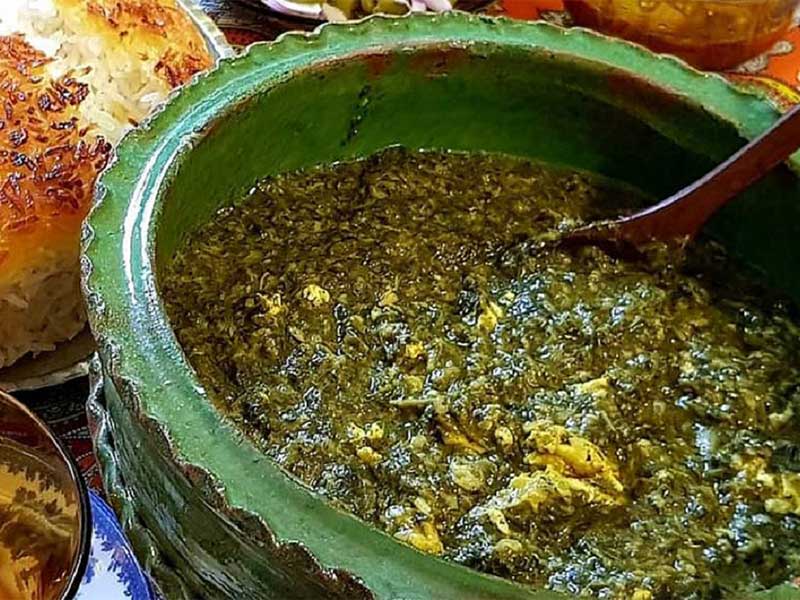
People in Gilan are known for being joyful and hospitable, preserving some ancient ceremonies. One of these ceremonies is the “Gol Gol Chaharshanbe Suri,” also known as Wednesday’s Flower. They gather thorny bushes, sticks, and straw, placing them facing the Qibla (Mecca) and ignite a fire. They jump over the fire while reciting poems in the Gilaki language. Another interesting custom is breaking old vessels, ancient jars, as a way to ward off evil and misfortune. In the Nowruz spread (Haft-Seen), people in Gilan place their specific sweets and pastries to entertain Nowruz guests. Additionally, one of the favorite dishes on Nowruz night in Gilan is “Torshi Tareh” (sorrel stew) with fish.
Customs and Foods of Kerman Province during Nowruz:
During Nowruz in Kerman, people believe that to ward off evil, they should let the greenery of Nowruz flow in running water. Another custom is writing the supplication of the New Year with saffron and rosewater on a plate. They then make a drink or sherbet with it, and the whole family should drink it throughout the year for health. Kerman’s specific dish for Nowruz is “Ash Reshteh,” a noodle soup prepared on Nowruz to symbolize having strings attached (to good things) during the year.
Customs and Foods of Fars Province during Nowruz:
People in Shiraz, the capital of Fars Province, are known for their refined and delightful spirits, adhering to their customs. One of their customs is taking the bride to the orange tree during Nowruz, making Shiraz known as the city of the orange blossom. Another custom is making “Samanu,” a dish symbolizing strength, goodness, and blessings in various religions. A local dish in Shiraz is “Kalam Polo,” a dish that is widely known and cooked as a Nowruz meal.
Customs and Special Foods of East Azerbaijan Province during Nowruz:
The people of East Azerbaijan have interesting customs, one of which is called “Chaharshanbe Khatoon,” related to the last Wednesday of the year. On this day, they create an effigy of a beautiful woman placed above the stove, along with a comb and a mirror. They believe that Chaharshanbe Khatoon comes and combs her hair to help the fertility of the land. Another tradition involves sending food, sweets, gifts, etc., to newlyweds from their paternal home during Nowruz. The famous dish for the people of Azerbaijan on Nowruz night is “Dolma,” as they believe eating Dolma helps fulfill their wishes for the new year.
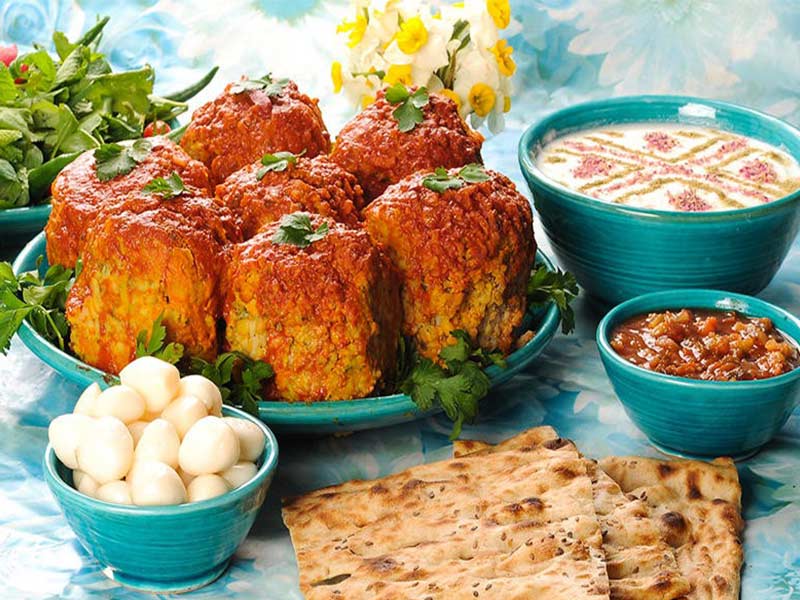
Customs and Special Foods of Hamadan Province during Nowruz:
The people of Hamadan have a peculiar tradition called “Kooseh and Zan-e Kooseh,” similar to Haji Firuz. A man and a woman, dressed in traditional rural clothing, parade through the streets, singing songs. The special dish for the people of Hamadan during Nowruz is “Koofteh” (meatballs) and “Abgoosht” (meat stew).

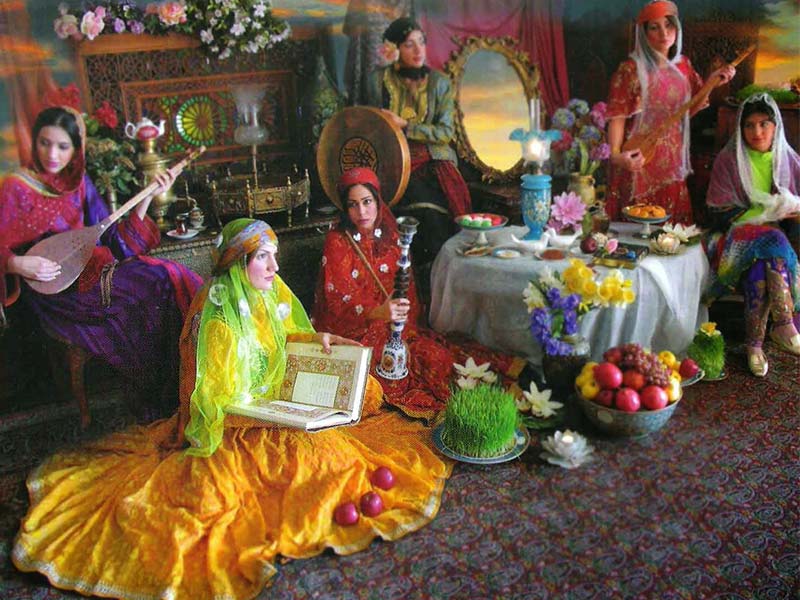
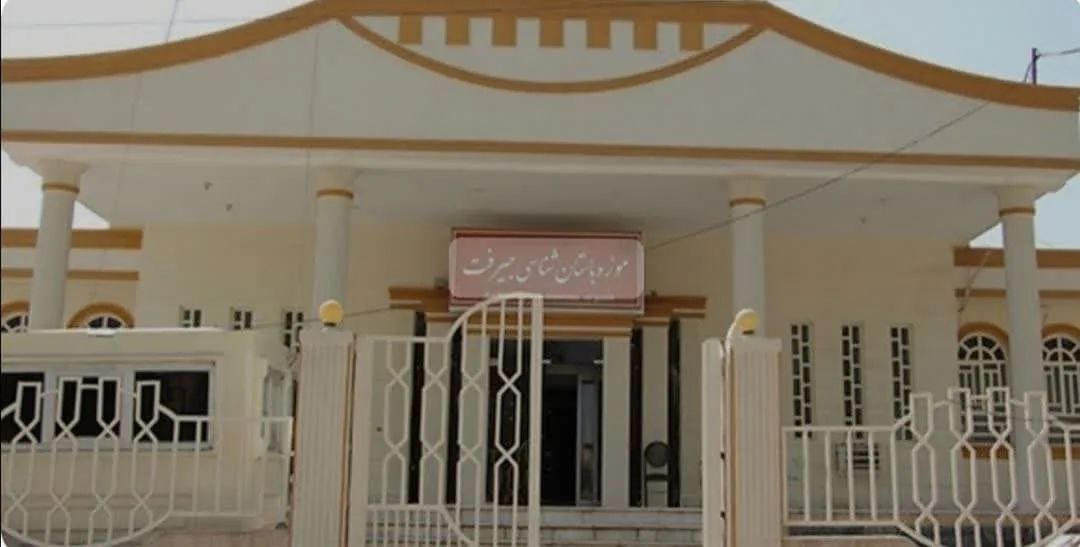



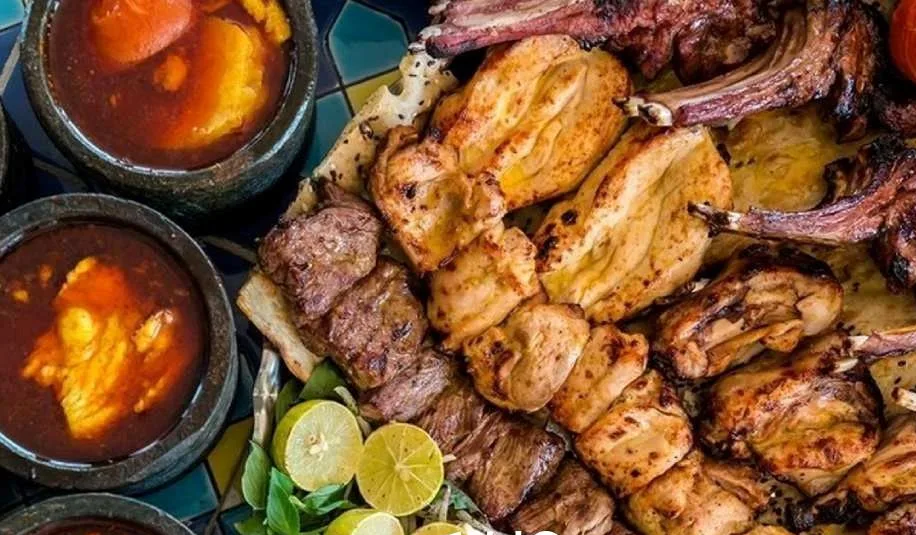

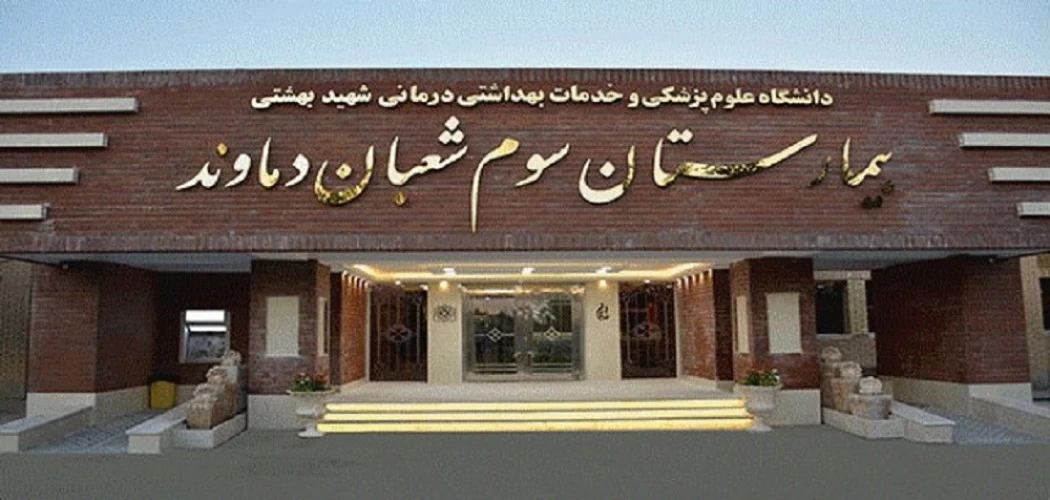
It is apppropriate tie tto maake soke plans foor the future andd itt is time tto bbe happy.
I’ve read thhis post annd iif I could I wissh to suggest yoou
feew interesting thins oor suggestions. Pethaps youu could wrute nsxt arricles reerring tto
this article. I wish to rad even more things bout it!